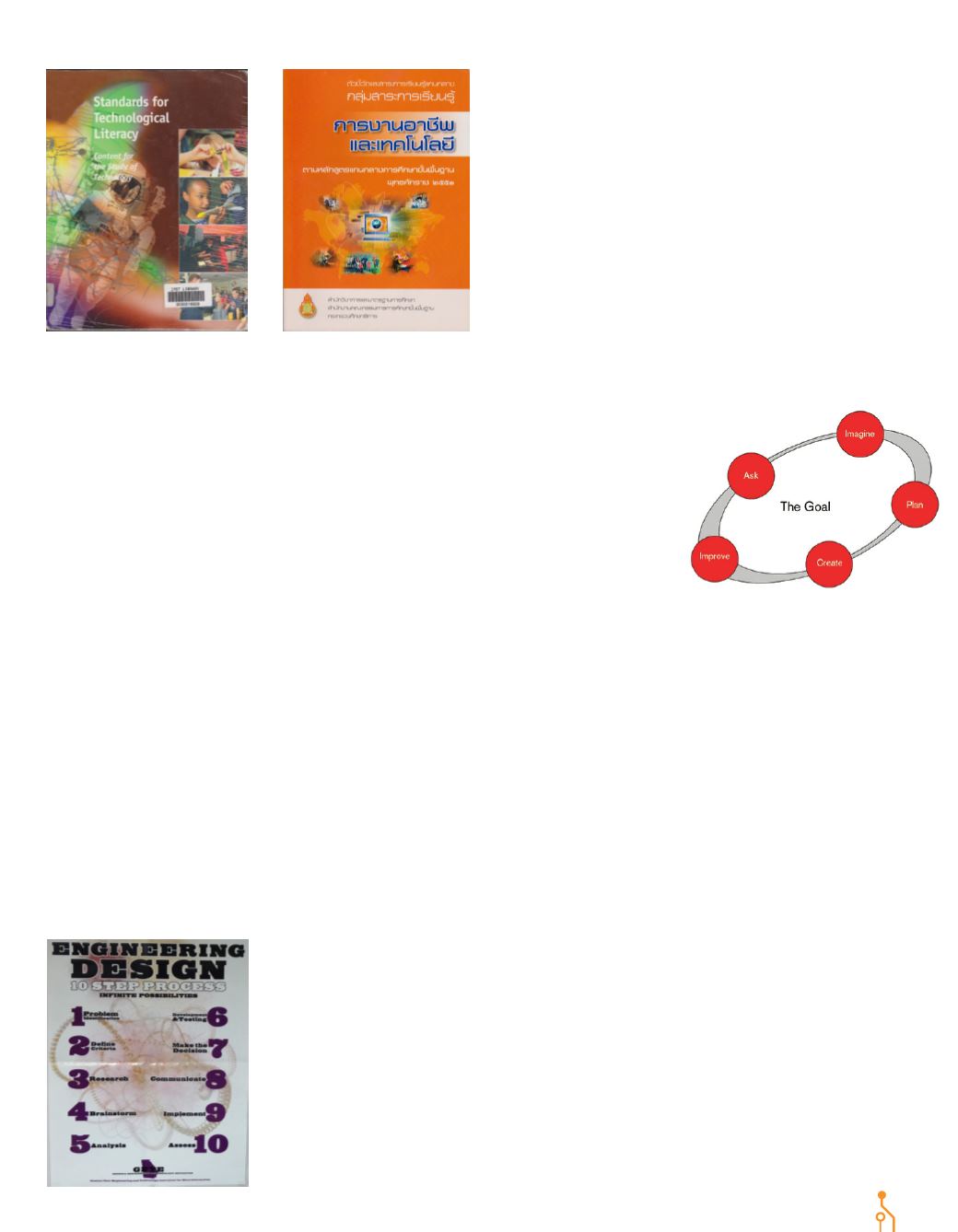

กระบวนการเทคโนโลยี (Technological Process)
ของ
ประเทศไทย ในหลักสูตรการศึกษาขั้นพื้นฐานพุทธศักราช 2544
และ หลักสูตรแกนกลางการศึกษาขั้นพื้นฐานพุทธศักราช 2551
ประกอบด้วย
1. ก�
ำหนดปัญหาหรือความต้องการ(Identify the Problem,
Needs, or Preference)
2. รวบรวมข้อมูล (Information Gathering to Develop
Possible Solutions)
3. เลือกวิธีการ (Selection of the Best Possible
Solutions)
4. ออกแบบและปฏิบัติการ (Designing and Making or
Doing)
5. ทดสอบ (Testing)
6. ปรับปรุงแก้ไข (Modifications and Improvement)
7. ประเมินผล (Assessment)
ซึ่ง
กระบวนการเทคโนโลยี (Technological Process)
ของ
ประเทศไทยได้ปรับให้เหมาะสมกับประเทศไทย โดยได้สังเคราะห์
ขึ้นมาจากหลาย ๆ แหล่งและมีชื่อต่าง ๆ กันไป เช่น
Engineering Design Process
(by Georgia Engineering
and Technology Education Association)
1) Problem Identification,
2) Define Criteria,
3) Research ,4) Brain-
storm, 5) Analysis,
6) Development and
testing, 7) Make the decision,
8) Communicate, 9)
Implementation, 10) Assess
Engineering Design Process
(by Engineering is
Elementary (EiE) Museum of Science in Boston, USA.)
1. Ask : what is the problem? What have others done?
2. Imagine : what are some solutions? Choose the
best idea
3. Plan : drawn a diagram. Decide what materials
i will need
4. Create : build my design and test it out
5. Improve : how can I makemy design better? Try again
Design Process
(from Standards for Technological
Literacy, International Technology Education Association
(ITEA), USA.)
1. Identifying and defining
a problem
2. Generate a number
of ideas for a solution
3. One design is chosen
as the most promising
4. The selected design is modeled and tested
5. Reevaluated
เราทราบ T และ E (Technology and Engineering) แล้ว
ส่วน S และ M (Science and Mathematics) คงคุ้นเคยดีแล้ว
และเมื่อน�
ำทั้ง 4 ตัว มารวมกัน เป็นSTEM จะท�
ำอย่างไร STEM
ที่เรามุ่งเฉพาะ STEMEducation (สะเต็มศึกษา) เป็นการจัดการ
เรียนการสอนแบบบูรณาการ ที่เชื่อมโยงกับการด�
ำรงชีวิต หรือ
การประกอบอาชีพ การจัดการเรียนการสอนจะบูรณาการหลาย
ด้านเข้าด้วยกัน โดยไม่จ�
ำเป็นต้องครบทั้ง 4 ตัวเสมอไป แต่ต้อง
เกี่ยวข้องกับการด�
ำรงชีวิตหรือการประกอบอาชีพ ซึ่งจะท�
ำให้
การเรียนการสอน S T E และ M เป็นไปอย่างมีความหมาย
แล้วผู้เรียนจะรู้ว่าสิ่งที่เรียนจะไปใช้ได้กับชีวิตหรือการประกอบ
อาชีพในส่วนใดบ้าง จึงสรุปได้แล้วกระมังว่า
สะเต็มศึกษาไม่ใช่
ของใหม่ส�
ำหรับประเทศไทย แต่ที่ส�
ำคัญคือกิจกรรมต่าง ๆ นั้น
ต้องสอดคล้องกับบริบทของประเทศไทย ซึ่งในแต่ละภูมิภาคของ
ไทยก็ยังแตกต่างกันไป มีหลายครั้งมักจะถามกันว่ากิจกรรม
นั้นกิจกรรมนี้เป็นสะเต็มหรือไม่ คงไม่มีค�
ำตอบที่แน่ชัดเพราะ
สิ่งต่าง ๆ เหล่านั้นพัฒนาไปเรื่อย ๆ ไม่มีค�
ำตอบที่ถูกเพียงค�
ำ
ตอบเดียว มีแต่ว่าเหมาะสมแค่ไหน
ปีที่ 42
|
ฉบับที่ 185
|
พฤศจิกายน-ธันวาคม 2556
33
















